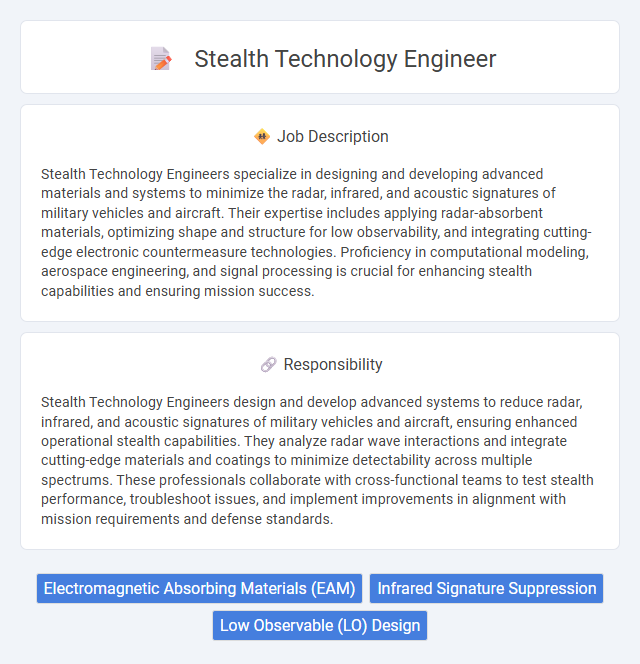
Stealth Technology Engineers specialize in designing and developing advanced materials and systems to minimize the radar, infrared, and acoustic signatures of military vehicles and aircraft. Their expertise includes applying radar-absorbent materials, optimizing shape and structure for low observability, and integrating cutting-edge electronic countermeasure technologies. Proficiency in computational modeling, aerospace engineering, and signal processing is crucial for enhancing stealth capabilities and ensuring mission success.
Individuals with strong analytical skills and a keen interest in aerospace or defense technologies are likely suitable for a Stealth Technology Engineer role. Those who thrive in highly confidential environments and can handle complex problem-solving tasks under pressure may find this career fitting. The position may be less ideal for candidates who prefer open, collaborative settings or who struggle with attention to detail and security protocols.
Qualification
A Stealth Technology Engineer must possess a strong background in aerospace or electrical engineering, with expertise in radar cross-section reduction, electromagnetic theory, and materials science. Proficiency in using advanced simulation software and familiarity with stealth aircraft design principles are essential qualifications. Experience in signal processing, radar systems, and compliance with military standards significantly enhances the candidate's capability to innovate and optimize stealth technologies.
Responsibility
Stealth Technology Engineers design and develop advanced systems to reduce radar, infrared, and acoustic signatures of military vehicles and aircraft, ensuring enhanced operational stealth capabilities. They analyze radar wave interactions and integrate cutting-edge materials and coatings to minimize detectability across multiple spectrums. These professionals collaborate with cross-functional teams to test stealth performance, troubleshoot issues, and implement improvements in alignment with mission requirements and defense standards.
Benefit
Stealth Technology Engineers likely enjoy competitive salaries due to the specialized nature of their work in defense and aerospace industries. They probably benefit from access to cutting-edge tools and materials, enhancing their skills and career growth opportunities. Job security may be high given the increasing demand for advanced stealth capabilities in military applications.
Challenge
Stealth Technology Engineer roles likely involve overcoming complex challenges related to reducing radar signatures and enhancing aircraft invisibility. There is a high probability that engineers face difficulties integrating advanced materials and cutting-edge technologies while maintaining performance and safety standards. Problem-solving and innovation are expected to be critical in addressing these demanding technical hurdles.
Career Advancement
Stealth Technology Engineers specializing in radar-absorbent materials and signature reduction techniques experience significant career growth through roles in advanced defense projects and aerospace innovation. Mastery of electromagnetic theory, materials science, and simulation software enhances opportunities for leadership positions within defense contractors and government agencies. Continuous skill development in adaptive camouflage, stealth aircraft design, and electronic warfare systems drives progression toward senior engineering and project management roles.
Key Terms
Electromagnetic Absorbing Materials (EAM)
Stealth Technology Engineers specializing in Electromagnetic Absorbing Materials (EAM) develop advanced composite materials designed to minimize radar cross-section by absorbing and dissipating electromagnetic waves. These engineers utilize cutting-edge nanotechnology and material science innovations to optimize EAM performance across diverse frequency ranges, enhancing the stealth capabilities of military aircraft and naval vessels. Proficiency in computational modeling and testing methodologies is essential for tailoring EAM properties to specific operational environments and threat profiles.
Infrared Signature Suppression
A Stealth Technology Engineer specializing in Infrared Signature Suppression develops advanced materials and coatings that minimize thermal emissions from aircraft and military vehicles, reducing detectability by infrared sensors. They utilize computational fluid dynamics and heat transfer modeling to design surfaces that dissipate heat efficiently while maintaining aerodynamic performance. Expertise in multispectral signal analysis and thermal imaging systems enables the engineer to validate signature reduction techniques and enhance stealth capabilities in operational environments.
Low Observable (LO) Design
A Stealth Technology Engineer specializing in Low Observable (LO) Design develops advanced materials and structures to minimize radar, infrared, and acoustic signatures of military aircraft and vehicles. Expertise in radar cross-section (RCS) reduction techniques, electromagnetic wave absorption, and shaping strategies enables the creation of platforms with enhanced survivability and mission effectiveness. Proficiency in simulation software such as ANSYS HFSS and experience with composite materials are critical for optimizing stealth performance in complex operational environments.
 kuljobs.com
kuljobs.com